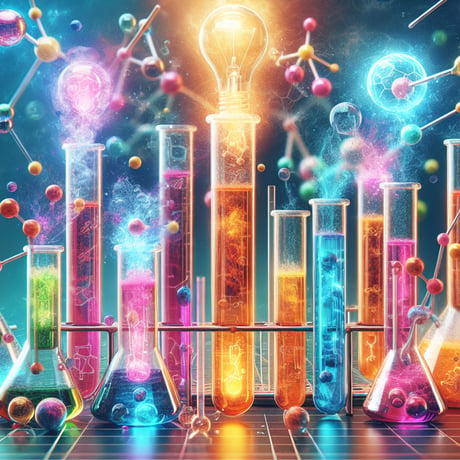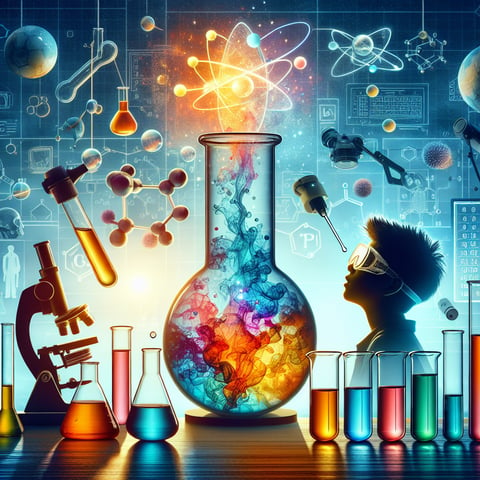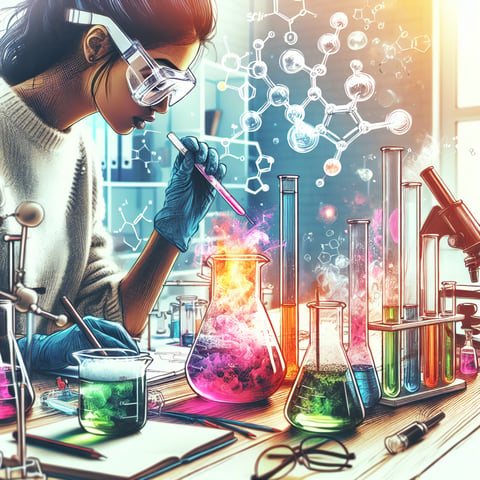Exploring Key Science Concepts with MEL Chemistry Kits
Explore key science concepts with MEL Chemistry kits. Delve into the world of chemistry, understand chemical reactions, atomic structure, the periodic table, states of matter, chemical bonding, acids and bases, and redox reactions. Hands-on and engaging learning experience.
EDUCATION
12/2/202310 min read
The MEL Chemistry kits offer a hands-on and engaging approach to exploring key science concepts. Designed for curious minds of all ages, these kits provide a unique opportunity to delve into the fascinating world of chemistry. From understanding acids and bases to investigating chemical reactions, each kit is carefully curated to ensure a comprehensive learning experience. With clear and concise instructions, along with high-quality materials and equipment, these kits offer an exciting way to learn and apply scientific knowledge. Whether you're a budding scientist or simply curious about the world around you, MEL Chemistry kits are a fantastic resource for exploring key science concepts.
Interested in MEL Science products? Check it out.
Chemical Reactions
Chemical reactions are the fundamental processes that drive the world of chemistry. They involve the transformation of substances into different ones, with the rearrangement of atoms and the breaking and formation of chemical bonds. One of the key principles that govern chemical reactions is the Law of Conservation of Mass.
Law of Conservation of Mass
The Law of Conservation of Mass states that in any chemical reaction, the total mass of the reactants must be equal to the total mass of the products. This means that matter is neither created nor destroyed during a chemical reaction, but rather it is conserved. This law helps scientists understand and predict the outcome of chemical reactions, as it ensures that the number and type of atoms in a reaction remain constant.
Types of Chemical Reactions
Chemical reactions can be classified into several different types based on the changes that occur during the reaction. Some common types of chemical reactions include:
Combination or synthesis reactions, where two or more substances combine to form a single, more complex substance.
Decomposition reactions, where a single substance breaks down into two or more simpler substances.
Displacement or replacement reactions, where one element replaces another element in a compound.
Combustion reactions, where a substance reacts rapidly with oxygen, usually producing heat, light, and often a flame.
By understanding the different types of chemical reactions, scientists can better predict the behavior of substances and develop more efficient and sustainable chemical processes.
Balancing Chemical Equations
Chemical equations are symbolic representations of chemical reactions. They show the reactants on the left side and the products on the right side, separated by an arrow. However, in order to accurately represent a chemical reaction, the equation must be balanced.
Balancing chemical equations involves ensuring that the number of atoms of each element is the same on both sides of the equation. This is achieved by adjusting the coefficients in front of the chemical formulas. It is essential to balance equations to accurately represent the stoichiometry of a reaction and to calculate the quantities of substances involved.
Atomic Structure
Understanding the structure of atoms is key to understanding the behavior of matter at the most fundamental level. Atoms are the building blocks of matter and are composed of three main components: protons, neutrons, and electrons.
Atoms and Elements
An atom is the smallest unit of an element that retains the chemical properties of that element. Elements, on the other hand, are substances that cannot be broken down into simpler substances by chemical means. Each element is defined by the number of protons it has in its nucleus, which is known as the atomic number. For example, hydrogen has an atomic number of 1, while carbon has an atomic number of 6.
Atomic Number and Mass Number
The atomic number of an element determines its position in the periodic table and represents the number of protons in an atom of that element. The mass number, on the other hand, represents the total number of protons and neutrons in the nucleus of an atom. It is denoted by the symbol "A" and is often written as a subscript to the left of the element's symbol.
Isotopes
Isotopes are atoms of the same element that have different numbers of neutrons. This means that while isotopes have the same atomic number and chemical properties, they have different mass numbers. For example, carbon-12 and carbon-14 are both isotopes of carbon, with carbon-12 being the most abundant. Isotopes have important applications in various fields, such as radiocarbon dating and medical imaging.
Periodic Table
The periodic table is a tabular arrangement of elements based on their atomic number, electron configuration, and recurring chemical properties. It is a powerful tool used by chemists to understand the relationships and patterns among elements.
Elements and Their Properties
The periodic table consists of rows, known as periods, and columns, known as groups or families. Each element is represented by a symbol and is classified based on its properties. Elements in the same group share similar properties and tend to react in similar ways, while elements in the same period have similarities in terms of the number of electron shells.
Periods and Groups
The periodic table is arranged in such a way that elements with similar chemical properties are placed in the same column. These columns are called groups or families. There are 18 such groups in the modern periodic table, with each group having a unique name and characteristics.
The periodic table also contains periods, which are the rows of elements. Each period represents a different energy level or electron shell. The number of elements in each period increases as you move down the table, with the first period consisting of only two elements (hydrogen and helium) and the seventh period being the longest with 32 elements.
Metallic and Non-metallic Elements
Elements in the periodic table can be classified as either metals or non-metals based on their properties. Metals are typically lustrous, malleable, and good conductors of heat and electricity. They are found on the left side and the middle of the periodic table. Non-metals, on the other hand, are generally poor conductors of heat and electricity and are located on the right side of the periodic table.
States of Matter
Matter exists in three main states: solid, liquid, and gas. The state of matter of a substance is determined by the strength of the forces between its particles and the amount of energy they possess.
Solid, Liquid, and Gas
In the solid state, particles are tightly packed together and have fixed positions. They vibrate around their positions but do not move freely. Solids have a definite shape and volume.
In the liquid state, particles are closer together compared to gases, but they can move around and slide past each other. Liquids take the shape of the container they are in and have a definite volume.
In the gas state, particles are far apart and move freely and rapidly. Gases have no fixed shape or volume and expand to fill the space available to them.
Changes in States of Matter
Matter can undergo changes in states, transitions from one state to another. These changes occur when the temperature or pressure of the substance is altered.
Melting is the change from a solid to a liquid, usually accompanied by the absorption of energy. Freezing is the reverse process, where a liquid changes to a solid, releasing energy.
Evaporation, also called vaporization, is the change from a liquid to a gas, typically at the surface of the liquid. Condensation is the reverse process, where a gas changes to a liquid, releasing energy.
Sublimation is the phase transition from a solid directly to a gas, bypassing the liquid state. Deposition is the reverse process, where a gas changes directly to a solid.
Phase Diagrams
Phase diagrams are graphical representations of the conditions at which a substance exists in different states. They provide information about the temperature and pressure ranges over which different phases of a substance are stable. Phase diagrams are valuable tools for understanding and predicting the behavior of substances under different conditions, such as determining the conditions at which a substance will melt, boil, or undergo other phase transitions.
Interested in MEL Science products? Check it out.
Chemical Bonding
Chemical bonding refers to the attraction between atoms that allows them to form compounds. It involves the sharing, gaining, or losing of electrons to achieve a stable electron configuration.
Ionic Bonds
Ionic bonds occur when atoms transfer electrons to form ions, resulting in the attraction between oppositely charged ions. Metal and non-metal atoms often form ionic bonds. The metal atom loses one or more electrons to form a positively charged ion called a cation, while the non-metal atom gains one or more electrons to form a negatively charged ion called an anion. These oppositely charged ions attract each other, forming an ionic bond.
Covalent Bonds
Covalent bonds occur when atoms share electrons to achieve a stable electron configuration. Covalent bonding typically occurs between non-metal atoms. The shared electrons are located in the outermost electron shells of both atoms, forming a bonding pair. Covalent bonds can be single, double, or triple, depending on the number of electron pairs being shared.
Polar and Non-polar Bonds
Covalent bonds can be classified as either polar or non-polar based on the electronegativity difference between the atoms involved. In a polar covalent bond, the electrons are not shared equally, resulting in a partial positive charge on one atom and a partial negative charge on another. In a non-polar covalent bond, the electrons are shared equally, resulting in a balanced distribution of charge.
The polarity of a bond is important for determining the overall polarity of a molecule and its interactions with other substances.
Acids and Bases
Acids and bases are essential substances in chemistry, playing crucial roles in many chemical reactions and processes.
pH Scale
The pH scale is a measure of the acidity or basicity of a solution. It ranges from 0 to 14, with 7 considered neutral. Solutions with a pH less than 7 are acidic, while solutions with a pH greater than 7 are basic. The pH of a solution is determined by the concentration of hydrogen ions (H+) and hydroxide ions (OH-) in the solution.
Acid-Base Reactions
Acid-base reactions involve the transfer of protons (H+) from an acid to a base. Acids are substances that donate protons, while bases are substances that accept protons. These reactions play a vital role in everyday life, from the digestion of food in our bodies to the neutralization of acids and the production of salts.
Neutralization
Neutralization is a specific type of acid-base reaction where an acid and a base react to form a salt and water. The reaction involves the combination of hydrogen ions (H+) from the acid and hydroxide ions (OH-) from the base to form water (H2O).
Neutralization reactions are widely used in various applications, such as the treatment of acidic soils, the purification of water, and the production of pharmaceuticals.
Redox Reactions
Redox (reduction-oxidation) reactions involve the transfer of electrons between substances. These reactions play a crucial role in energy conversion processes and are fundamental to many chemical reactions.
Oxidation and Reduction
Oxidation is the loss of electrons from a substance, resulting in an increase in its oxidation state. Reduction is the gain of electrons by a substance, resulting in a decrease in its oxidation state. Oxidation and reduction always occur together and are referred to as redox reactions.
Oxidation States
The oxidation state, also known as the oxidation number, is a measure of the degree of oxidation or reduction of an atom in a compound. It indicates the number of electrons that an atom has gained or lost relative to its neutral state. The oxidation state is represented by a positive or negative number or zero.
Understanding oxidation states is essential for balancing redox equations and determining the electron transfer that occurs during a reaction.
Electrochemical Cells
Electrochemical cells are devices in which redox reactions occur to generate electrical energy or to perform chemical reactions. They consist of two electrodes, an anode (where oxidation occurs) and a cathode (where reduction occurs), connected by an electrolyte. Electrochemical cells have important applications, such as batteries, fuel cells, and electrolysis.
Thermodynamics
Thermodynamics is the branch of chemistry that deals with energy changes in chemical reactions and the transfer of heat and work.
Energy Transfer in Chemical Reactions
Chemical reactions involve the breaking and formation of chemical bonds, which require or release energy. The energy changes in a reaction can be classified as exothermic (releasing energy) or endothermic (absorbing energy). Understanding these energy changes is crucial for predicting the outcome and feasibility of reactions.
Entropy and Enthalpy
Entropy and enthalpy are key concepts in thermodynamics. Entropy is a measure of the disorder or randomness of a system. In chemical reactions, the entropy change can be positive (increasing disorder) or negative (decreasing disorder). Enthalpy, on the other hand, is a measure of the total heat content of a system. It can be positive (endothermic) or negative (exothermic).
Spontaneity
Spontaneous reactions are reactions that occur naturally without the need for external input of energy. The spontaneity of a reaction is determined by the combined effects of entropy and enthalpy changes. Reactions with a negative Gibbs free energy (ΔG) value are spontaneous and tend to proceed in the forward direction.
Understanding thermodynamics helps scientists predict and control the direction of chemical reactions and optimize energy usage in various applications.
Reaction Rates
Reaction rates refer to the speed at which a chemical reaction occurs. They are influenced by several factors, including temperature, concentration, surface area, and the presence of catalysts.
Factors Affecting Reaction Rates
Temperature affects reaction rates by increasing the kinetic energy of particles, leading to more frequent and energetic collisions. Increasing the concentration of reactants increases the chance of particles colliding, thus increasing reaction rates. Greater surface area exposes more reactant particles, leading to increased collision frequency and higher reaction rates.
Collision Theory
The collision theory states that for a chemical reaction to occur, reactant particles must collide with sufficient energy and with the proper orientation. Not all collisions result in reaction, as some may not have enough energy to overcome the activation energy barrier.
Catalysts
Catalysts are substances that increase the rate of a reaction by providing an alternative reaction pathway with lower activation energy. Catalysts remain unchanged at the end of the reaction and can be used repeatedly. They play a vital role in many industrial processes and are key to developing more efficient and sustainable chemical processes.
Organic Chemistry
Organic chemistry is the study of carbon-containing compounds, which are the basis of all living organisms. It is a diverse and fascinating field that explores the structure, properties, composition, reactions, and synthesis of organic compounds.
Hydrocarbons
Hydrocarbons are organic compounds composed of only carbon and hydrogen atoms. They are the simplest and most abundant organic compounds and form the basis of many organic molecules. Hydrocarbons can exist in different forms, such as alkanes, alkenes, alkynes, and aromatic compounds. They have important applications as fuels and raw materials in various industries.
Functional Groups
Functional groups are specific atoms or groups of atoms attached to the carbon backbone of organic compounds. They determine the chemical reactivity and properties of organic molecules. Some common functional groups include hydroxyl (-OH), carbonyl (C=O), carboxyl (-COOH), and amino (-NH2). Understanding functional groups is essential for predicting the behavior of organic compounds and designing new molecules.
Isomerism
Isomerism is the phenomenon where two or more compounds have the same molecular formula but different structural arrangements or spatial orientations. Isomers can have different physical and chemical properties due to their different arrangement of atoms or spatial orientation of functional groups. Understanding isomerism is crucial in organic chemistry, as it helps chemists identify and differentiate between different compounds with the same molecular formula.
In conclusion, MEL Chemistry kits cover a wide range of key science concepts, providing an engaging and hands-on approach to learning about chemical reactions, atomic structure, the periodic table, states of matter, chemical bonding, acids and bases, redox reactions, thermodynamics, reaction rates, and organic chemistry. By exploring these concepts, students can develop a solid foundation in chemistry, enabling them to better understand the world around them and pursue further studies in this fascinating field.
Interested in MEL Science products? Check it out.






